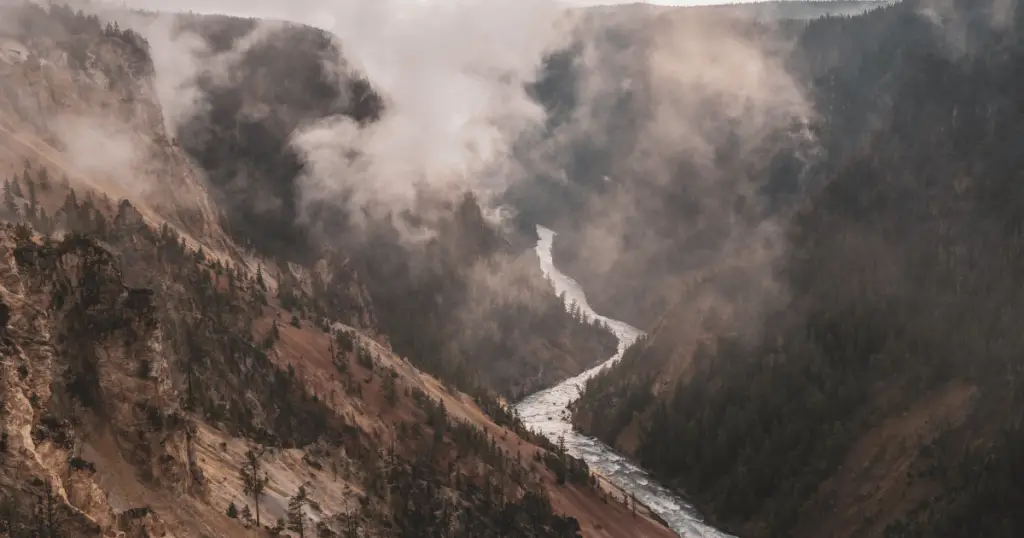Exploring Yellowstone National Park in September: A Fall Adventure
Yellowstone National Park, located in the heart of the United States, is a world-famous destination that attracts visitors from all over the globe. If you plan a trip to Yellowstone in September, you’re in for a delightful experience. The weather is pleasant, and the crowds are usually manageable, making it an ideal time to explore the park’s beauty and engage in various activities.

Yellowstone in Fall
The fall season brings a special kind of magic to Yellowstone. As the days grow shorter and temperatures drop, you can expect wildlife sightings to increase; elk, deer, bears, wolves, and bison are often seen feasting on the abundance of autumn vegetation or making their way through the park in search of new territory.
Visitors can enjoy some incredible scenery as autumn colors appear in the park. From golden aspens and red maple trees that line the meadows to towering pines glowing in a spectrum of yellows, browns, oranges, and reds.
Changing Landscapes
Yellowstone National Park is a showcase of geological wonders and breathtaking landscapes. Its iconic features include the vibrant, mineral-laden Grand Prismatic Spring, the formidable Old Faithful geyser, and the imposing Yellowstone Canyon, often referred to as the Grand Canyon of Yellowstone.
Each spectacle presents an enchanting view, their natural beauty enhanced by the changing seasons. As summer eases into fall, the park undergoes a stunning transformation.
The lush greens of the summer foliage slowly give way to a palette of warm autumn hues, with aspens and cottonwoods flaunting vibrant shades of yellow and orange.
This colorful spectacle is an enchanting sight, making a fall visit to Yellowstone National Park an unforgettable experience.
Wildlife Activity
Yellowstone National Park is a wildlife enthusiast’s paradise, home to a diverse array of species. The park’s inhabitants contribute significantly to its allure from the majestic elk herds to the solitary grizzly bears, the playful otters to the soaring eagles.
In preparation for the harsh winter, these animals exhibit fascinating behaviors. Bears, for instance, enter a phase of excessive eating known as hyperphagia to build up fat reserves.
Conversely, Elk are amid their rutting season, where males engage in fierce battles for the right to mate. These captivating wildlife displays add extra excitement to any fall visit to Yellowstone.

Ideal Conditions
September sees a significant reduction in visitor numbers compared to the peak summer months of July and August. This downward trend in foot traffic allows you to experience the park’s splendors with fewer interruptions and more personal space. It’s as though the park has been opened up just for you.
Improved accessibility to popular sites and trails is another advantage of visiting Yellowstone in September. With fewer crowds, popular attractions such as Old Faithful, Mammoth Hot Springs, or the Grand Canyon of Yellowstone are less congested, allowing for a more serene and intimate experience.
Trails that may have been crowded during summer become pathways to solitude and unspoiled nature. This ease of access enhances the overall experience, allowing visitors to fully immerse themselves in Yellowstone’s magic.
Exploring Activities
There’s a wide variety of activities when planning a trip to Yellowstone in September. You can explore the park’s stunning natural beauty by hiking or marvel at the unique geological features by visiting the geothermal areas.
If you’re into photography, Yellowstone offers some of the most breathtaking landscapes and wildlife opportunities to capture stunning shots.
Hiking Adventures
Yellowstone National Park boasts an extensive network of trails suitable for hikers of all skill levels. Novice hikers can enjoy relatively flat and short trails like the Geyser Basin trails and traverse through steamy geothermal landscapes. For more experienced hikers seeking a challenge, the Mount Washburn trail offers a vigorous climb culminating in panoramic views of the park.

These trails offer hikers the chance to intimately experience Yellowstone’s breathtaking landscapes and witness its natural wonders up close. The Mystic Falls trail, for instance, takes you through a fascinating journey of geothermal features and wildflower-filled meadows and ultimately leads to a magnificent waterfall. Every trail offers its own unique set of attractions, each more awe-inspiring than the last.
Geothermal Marvels
Undeniably, one of the park’s biggest draws is its geothermal marvel, Old Faithful. This geyser is renowned for its predictable eruptions, blasting thousands of gallons of boiling water up to 180 feet into the sky approximately every 90 minutes. Besides Old Faithful, the park has several lesser-known but equally fascinating geothermal features.
The Grand Prismatic Spring, the largest hot spring in the U.S., mesmerizes visitors with its vibrant, rainbow-like colors. Norris Geyser Basin, the oldest and hottest of Yellowstone’s thermal areas, is also worth a visit, featuring a variety of unique, colorful pools and geysers.
Photography Opportunities
Yellowstone offers countless opportunities for capturing stunning photographs. The early morning light at Hayden Valley can create dramatic shadows and highlights, perfect for landscape photography. With its reflective surface, Lake Yellowstone provides an ideal backdrop for capturing sunrise or sunset hues.
Timing and patience are key when capturing the park’s vibrant fall colors and diverse wildlife. The golden hours—shortly after sunrise or just before sunset—are prime times for showcasing the warm autumn hues and catching wildlife in action.
Always be patient and ready, as wildlife can appear unexpectedly, and the perfect lighting condition can be fleeting.

Cultural and Educational Experiences
Yellowstone National Park not only offers unparalleled outdoor experiences but also provides educational and cultural opportunities to visitors. You can gain a deeper understanding of the park’s geology, wildlife, and human history through ranger-led programs and visitor centers.
Ranger Programs
To further enrich your Yellowstone experience, the park offers a variety of Ranger Programs that cater to visitors of all ages. These educational programs include captivating talks and guided walks led by experienced park rangers.
Topics usually cover various subjects, from Yellowstone’s dynamic geology to its complex ecosystems, offering visitors an in-depth understanding of the park’s intricate workings.
Participating in Ranger Programs provides a multitude of benefits. It allows visitors to learn about the park’s vast history, unique geology, and diverse ecology directly from knowledgeable sources. This interactive learning experience enhances visitors’ appreciation of the park and promotes responsible visitation and conservation efforts.
Visitor Centers
Yellowstone’s Visitor Centers and museums are crucial in offering insights into the park’s rich heritage. Information centers like the Old Faithful Visitor Education Center or the Canyon Visitor Education Center are treasure troves of information, providing detailed knowledge about the park’s geothermal activity, wildlife, and history.
These centers feature interactive exhibits and displays that visually and practically enhance visitors’ understanding of Yellowstone.
From relief maps and 3D models to immersive video presentations, the educational resources at these centers make learning about Yellowstone’s multifaceted environment a fascinating experience.
Visitors thus gain a thorough comprehension of the park, helping them to appreciate its natural wonders better.
Conclusion: Yellowstone in September
Visiting Yellowstone National Park in September offers a unique experience that combines breathtaking natural beauty, diverse wildlife, and rich cultural history. With favorable weather conditions, reduced crowds, and improved accessibility, visitors can fully immerse themselves in the park’s majestic landscapes and awe-inspiring geothermal marvels.
The park’s extensive network of hiking trails accommodates adventurers of all skill levels, while its geothermal features make for an unparalleled visual spectacle. Engaging in cultural and educational experiences such as ranger programs and visitor centers further enriches the visitor’s journey, providing a deeper understanding of the park’s ecosystem and history.






